Welcome to the Ryobi 1900 PSI Pressure Washer Manual! This guide provides essential information for safe and effective operation, maintenance, and troubleshooting of your powerful cleaning tool.

Key Features of the Ryobi 1900 PSI Pressure Washer
The Ryobi 1900 PSI Pressure Washer combines powerful performance with portability, featuring an electric motor and compact design for versatile cleaning tasks around the house.
2.1. 1900 PSI and 1.2 GPM Flow Rate
The Ryobi 1900 PSI Pressure Washer delivers a powerful cleaning experience with 1900 pounds per square inch of pressure and a flow rate of 1.2 gallons per minute. This combination ensures efficient removal of dirt and grime from various surfaces. The high pressure is ideal for tough stains and heavy-duty cleaning tasks, while the 1.2 GPM flow rate provides consistent water supply for optimal performance. Whether cleaning driveways, decks, or vehicles, this pressure washer offers the perfect balance of power and precision for a wide range of outdoor cleaning needs.
2.2. Electric Motor and Compact Design
The Ryobi 1900 PSI Pressure Washer features a robust electric motor designed for reliable performance and minimal noise. Its compact design makes it lightweight and easy to maneuver, perfect for small to medium-sized cleaning tasks. The motor delivers consistent power, while the streamlined build allows for easy storage in tight spaces. This combination of power and portability ensures that you can tackle outdoor cleaning projects efficiently without sacrificing convenience. The electric motor also eliminates the need for gasoline, reducing maintenance and emissions, making it an eco-friendly choice for homeowners seeking a dependable pressure washer;
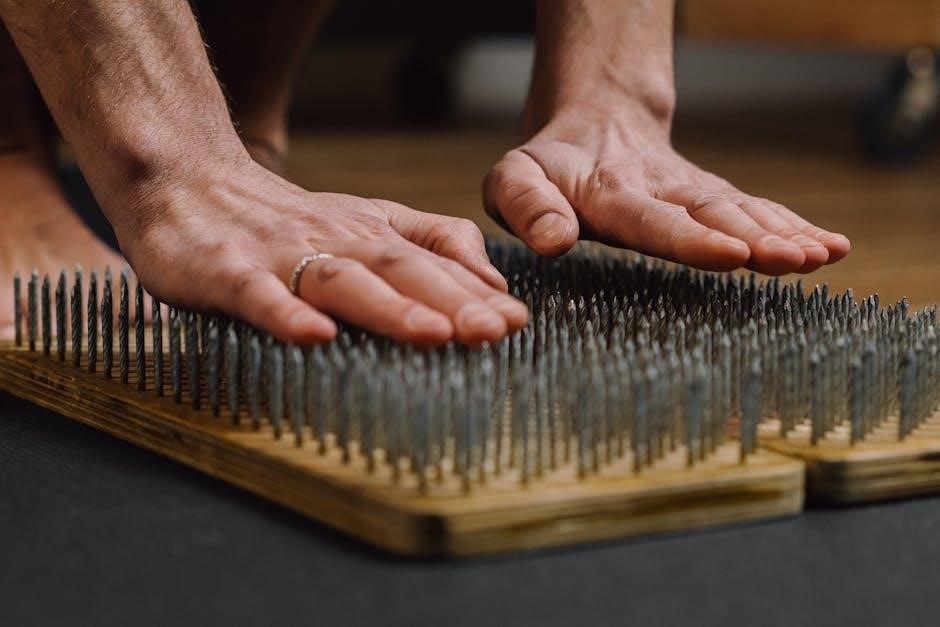
Safety Precautions and Warnings
Always read the manual and follow safety guidelines to avoid accidents. Wear protective gear, avoid sensitive surfaces, and keep children away. Never expose electrical parts to water.
3.1. General Safety Guidelines
Before using the Ryobi 1900 PSI Pressure Washer, ensure you read and understand all safety instructions. Always wear protective gear, including safety glasses and gloves, to prevent injury from high-pressure spray. Keep children and pets away from the operating area. Avoid using the pressure washer near open flames or sparks, and never point the nozzle at people or animals. Ensure the surface is clear of debris and flammable materials. Regularly inspect hoses and connections for damage. Follow all warnings and precautions outlined in the manual to ensure safe and effective operation.
3.2. Protective Gear Recommendations
When operating the Ryobi 1900 PSI Pressure Washer, wear appropriate protective gear to minimize injury risks. Safety glasses or goggles are essential to protect eyes from debris and high-pressure spray. Gloves provide grip and hand protection from abrasions. Closed-toe shoes or boots are recommended to prevent foot injuries. Avoid loose clothing that could get caught in the equipment. Consider wearing long sleeves and pants to shield skin from potential spray. Proper protective gear ensures a safer and more controlled cleaning experience, aligning with the manual’s safety guidelines for optimal user protection;
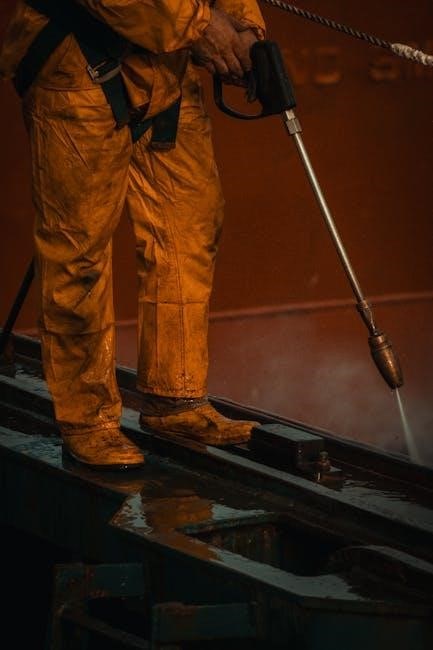
Assembly and Initial Setup
Begin by carefully unpacking and inventorying all parts. Attach the hose to the pump and spray gun securely. Connect the power cord and ensure all components are tightly fitted. Refer to the manual for precise instructions to avoid errors. Double-check connections for leaks before first use. Proper assembly ensures safe and efficient operation of your Ryobi 1900 PSI Pressure Washer.
4.1. Unpacking and Inventory of Parts
Start by carefully opening the box and removing all components. Lay out each part, including the pressure washer unit, hose, spray gun, nozzles, and power cord. Refer to the manual’s parts diagram to ensure all items are accounted for. Check for any visible damage or missing components. Take note of the nozzle sizes and their purposes. Organize the parts neatly to avoid misplacement. Verify that all accessories, such as the detergent tank or extra nozzles, are included. If any parts are missing or damaged, contact customer support immediately. Proper inventory ensures a smooth assembly process.
4.2. Attaching the Hose and Spray Gun
First, locate the hose and spray gun. Attach one end of the hose to the pressure washer’s pump outlet, ensuring it clicks securely into place. Tighten the connection by hand or with a wrench if necessary. Next, connect the other end of the hose to the spray gun. Make sure the connection is tight to prevent leaks. Finally, test the assembly by gently tugging on the hose and gun to ensure they are securely attached. Properly attaching these components is crucial for safe and effective operation of the pressure washer.
4.3. Installing the Pressure Washer Nozzle
Installing the pressure washer nozzle is a straightforward process. First, ensure the nozzle is compatible with your Ryobi 1900 PSI model. Align the nozzle with the spray gun’s receptacle, ensuring it fits snugly. Gently push the nozzle into place and twist it clockwise until it clicks securely. Test the connection by tugging lightly on the nozzle to ensure it’s properly attached. For optimal performance, select the appropriate nozzle for your task, such as a wide fan nozzle for large areas or a narrow nozzle for tough stains. Always follow the manufacturer’s recommendations for nozzle usage.

Operating Instructions
Plug in the pressure washer, prime the pump, and turn it on. Use the spray gun with the appropriate nozzle for your cleaning task. Always follow safety guidelines and operate the machine on a stable surface for optimal performance and efficiency.
5.1. Priming the Pump Before First Use
Before initial use, ensure the pump is primed to prevent damage and ensure proper function. Locate the priming valve, typically found near the water inlet. Open it slightly, allowing water to flow through the system for about 30 seconds. This process removes air from the pump and hoses. Once water flows steadily, close the valve and proceed. Priming is essential for maintaining the longevity and efficiency of your Ryobi 1900 PSI pressure washer. Always refer to the manual for specific priming instructions tailored to your model.
5.2. Starting and Stopping the Pressure Washer

To start the Ryobi 1900 PSI pressure washer, ensure it is placed on a level surface and plugged into a grounded electrical outlet. Attach the high-pressure hose and spray gun securely. Select the appropriate nozzle for your task and squeeze the trigger to begin operation. For stopping, release the trigger to relieve pressure, then switch off the power button. Allow the motor to cool briefly before storage. Always follow these steps to ensure safe and efficient operation of your pressure washer.
5.3. Adjusting the Spray Nozzle for Different Tasks
Adjusting the spray nozzle on your Ryobi 1900 PSI pressure washer is crucial for optimal performance. Start by selecting the appropriate nozzle for your task—narrow nozzles for heavy-duty cleaning and wider nozzles for lighter jobs. To install, align the nozzle with the spray gun and twist until it clicks securely. Test the spray pattern to ensure proper adjustment. For precise control, use the variable spray tip to modify the fan width by adjusting the nozzle collar. Always wear protective gear and maintain a safe distance from surfaces. Proper nozzle adjustment ensures efficient cleaning and prevents damage to surfaces.
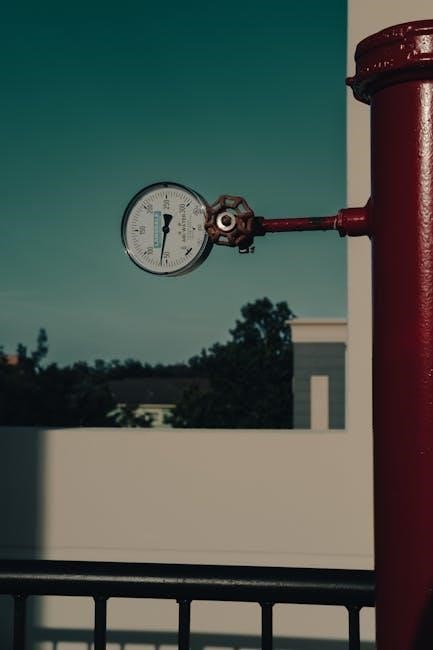
Maintenance and Troubleshooting
Regular maintenance ensures optimal performance and longevity of your Ryobi 1900 PSI pressure washer. Clean the filter and nozzle regularly, check for wearable parts, and winterize properly to avoid issues.
6.1; Cleaning the Filter and Nozzle
Regular cleaning of the filter and nozzle is crucial for maintaining your Ryobi 1900 PSI pressure washer’s performance. Turn off the power and disconnect the hose. Remove the filter and rinse it with clean water to eliminate debris. For the nozzle, soak it in warm water or use a soft brush to clear blockages. Ensure all components are dry before reassembling. This process prevents clogs and ensures consistent water flow. Refer to your manual for specific diagrams or instructions if needed. Proper maintenance helps extend the lifespan of your pressure washer and keeps it functioning efficiently.
6.2. Checking and Replacing Wearable Parts
Regularly inspect the wearable parts of your Ryobi 1900 PSI pressure washer, such as seals, O-rings, and hoses, for signs of wear or damage. Turn off the power and disengage the pump before examining these components. Replace any worn or damaged parts with genuine Ryobi replacements to ensure optimal performance. Failure to address worn parts can lead to reduced efficiency or further damage to the unit. Always refer to the manual for specific part numbers and instructions. Regular checks help prevent unexpected breakdowns and keep your pressure washer functioning at its best.
6.3. Winterizing the Pressure Washer
To winterize your Ryobi 1900 PSI pressure washer, drain all water from the system to prevent freezing damage. Disconnect the hoses and spray gun, then run the pump for a few seconds to clear residual water. Use a pump saver kit or pour antifreeze into the inlet to protect internal components. Store the unit in a dry, cool place, away from direct sunlight. Ensure all connections are sealed to avoid moisture buildup. Proper winterization extends the lifespan of your pressure washer and ensures it’s ready for use in the spring. Always follow the manual for detailed steps to protect your investment.
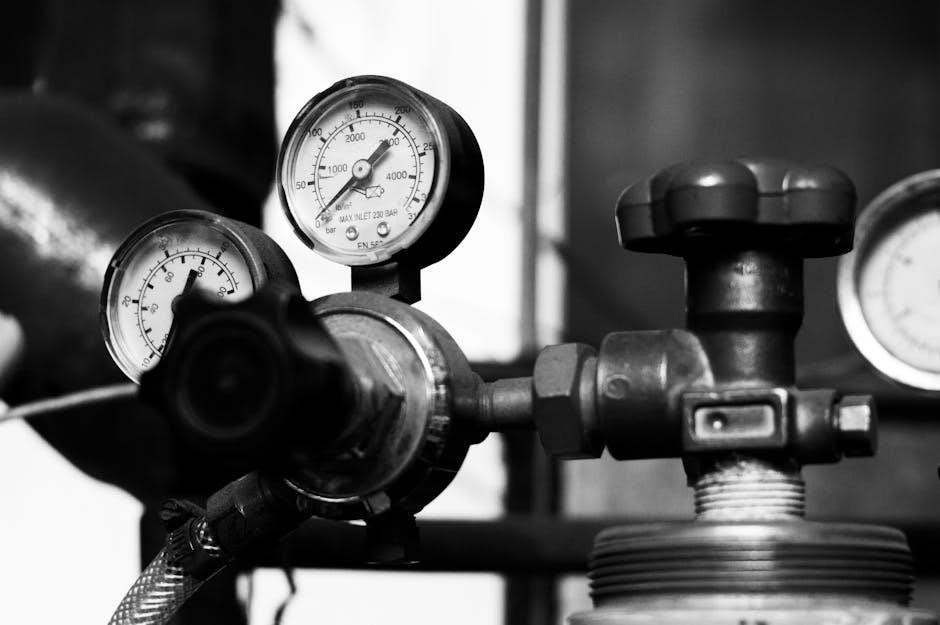
Common Issues and Solutions
Addressing common issues like low pressure, leaks, or nozzle clogs ensures optimal performance. Troubleshooting tips and solutions are provided to help you resolve problems quickly and effectively.
7.1. Low Pressure or No Water Flow
Low pressure or no water flow can occur due to blockages or improper setup. Check for kinked hoses, clogged nozzles, or a blocked filter. Ensure the water supply is turned on fully and the pressure washer is set to the correct pressure setting. Clean or replace any obstructed parts, such as the nozzle or filter, to restore proper function. If issues persist, consult the troubleshooting section for additional guidance or consider professional assistance to resolve the problem effectively.
7.2. Leaks in the Hose or Connections
Leaks in the hose or connections can lead to reduced performance and water wastage. Inspect all connections for tightness and ensure they are properly secured. If a leak is found, turn off the pressure washer and inspect the hose for damage or wear. Replace any damaged sections or worn-out O-rings. Apply Teflon tape or a sealant to threaded connections to prevent leaks. Regularly checking and maintaining these areas will help maintain optimal performance and extend the lifespan of your Ryobi 1900 PSI Pressure Washer.
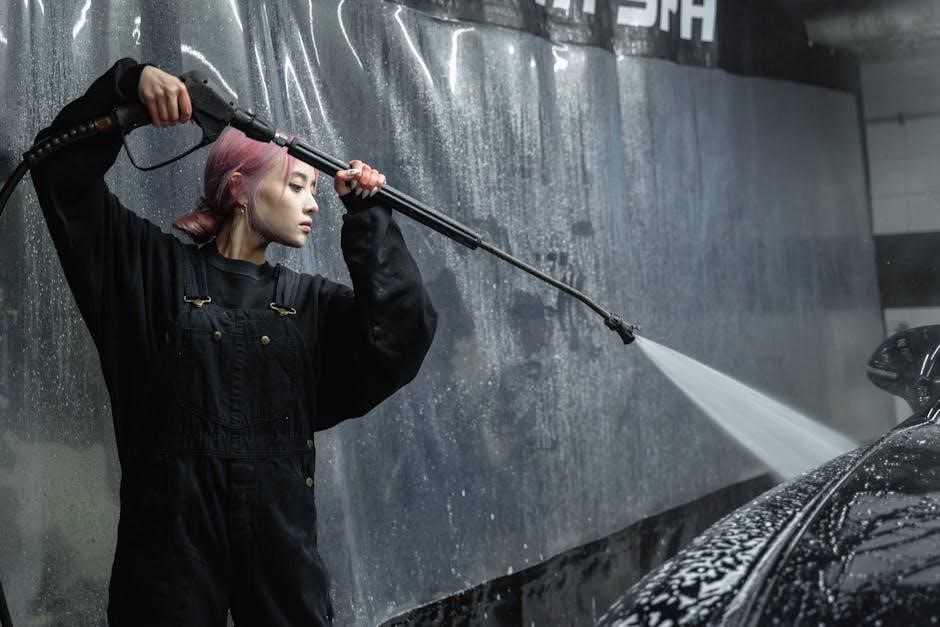
Storage and Transportation
Store the pressure washer in a dry, protected area away from extreme temperatures. For transportation, secure the unit firmly to prevent movement and potential damage during transit.
8.1. Proper Storage Conditions
Store the Ryobi 1900 PSI Pressure Washer in a dry, well-ventilated area protected from direct sunlight and extreme temperatures. Avoid exposing the unit to freezing conditions or humidity. Ensure the storage location is level and stable to prevent tipping. Before storing, drain all water from the hose and pump to avoid freezing damage during winter. Keep the pressure washer upright and secure to prevent accidental movement. Regularly inspect the storage area for signs of moisture or pests. Proper storage ensures longevity and maintains the unit’s performance for future use.
8.2. Safe Transportation Practices
Ensure the Ryobi 1900 PSI Pressure Washer is securely fastened during transport to prevent movement or damage. Drain all water from the hose, pump, and tank to avoid leaks. Protect fragile components like the pump and motor by using the original packaging or padding. Transport the unit in an upright position to maintain balance and stability. Avoid exposing the pressure washer to extreme temperatures or direct sunlight during transit. Use a suitable vehicle, such as a truck or trailer, and tie down the unit firmly. Always follow local transportation regulations and safety guidelines to ensure safe arrival at your destination.

Environmental Considerations
Responsible ownership involves eco-friendly practices. Use detergent sparingly, avoid washing sensitive surfaces, and dispose of waste properly to protect the environment while maintaining performance and longevity.
9.1. Eco-Friendly Usage Tips
Adopt eco-conscious practices to minimize environmental impact while using your Ryobi 1900 PSI Pressure Washer. Use biodegradable detergents sparingly to avoid harming plants or water systems. Avoid washing sensitive surfaces like wood or plants with high pressure. Collect and properly dispose of wastewater to prevent contamination. Regularly clean filters and nozzles to maintain efficiency, reducing unnecessary water and energy use. Store the pressure washer in a dry, protected area to prevent rust and extend its lifespan, reducing waste. By following these tips, you can enjoy effective cleaning while promoting sustainability.
9.2. Disposal of Waste and Old Parts
Properly dispose of waste and old parts from your Ryobi 1900 PSI Pressure Washer to protect the environment. Recycle metal components like worn nozzles or hoses by taking them to designated recycling centers. Check local regulations for hazardous waste disposal, as some parts may contain chemicals. Do not discard old parts in regular trash; instead, use community drop-off programs. Dispose of cleaning detergents responsibly, ensuring they do not enter waterways. Always follow eco-friendly guidelines when handling waste to minimize environmental impact and promote sustainability.
Your Ryobi 1900 PSI Pressure Washer Manual has provided comprehensive guidance for safe operation, maintenance, and troubleshooting. By following these instructions, you can maximize efficiency and extend the lifespan of your pressure washer. Always prioritize safety, regular maintenance, and eco-friendly practices. If you encounter any issues, refer back to the troubleshooting sections for solutions; Keep this manual handy for future reference, ensuring you can continue to use your Ryobi 1900 PSI Pressure Washer effectively for years to come. Happy cleaning!
